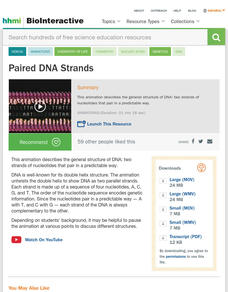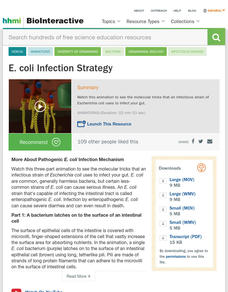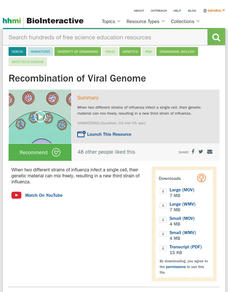SciShow
New Evidence of Water on Jupiter! SciShow News
The longest continuous storm in the solar system, known as the Great Red Spot on Jupiter, contains water. Scientists theorized this, but now Juno proved it during multiple trips around Jupiter. Interestingly, Juno also discovered that...
Crash Course
The Computer and Turing: Crash Course History of Science #36
Computers have changed the world but how have computers themselves changed? A Crash Course History of Science episode focuses on the the history of the computer. It opens with defining what a computer is and continues by introducing the...
Crash Course
Genetics and the Modern Synthesis: Crash Course History of Science #35
Can competing biological theories both be correct? Explore the two theories many scientists believed were opposing in a Crash Course History of Science video. The narrator covers both Darwin's and Mendel's genetics theories, the...
Crash Course
The Atomic Bomb: Crash Course History of Science #33
Einstein, a famous pacifist, sent a letter to FDR encouraging development of a nuclear weapon. An interesting video opens with this historical event and moves through the development of atomic bombs. It shares the use of atomic weapons...
Howard Hughes Medical Institute
Paired DNA Strands
What happens when you untwist and unzip DNA? View the fascinating process and learn about the pieces that make up DNA in an informative video. It highlights the base pairing and sequencing rules within each strand.
PBS
Marine Arthropod Animation: Body Plan
Lobsters never stop growing and one lived to be almost four feet long. The Shape of Life series focuses on the body plan of lobsters including their growth patterns. It discusses the legs, appendages, and body segments as they appear...
SciShow
The Hottest Planet Ever
Have you ever wanted to visit the sun? While that's not an option given the temperatures involved, use a SciShow Space video to learn about the probe headed to the sun to help people understand a few things that confuse scientists. The...
SciShow
How Studying Venus Saved Earth
Scientists discovered a hole in the ozone layer in 1980, and by 2000, the hole was three times the size of the United States. Through global efforts, scientists discovered the cause and worked together to get countries to implement a...
SciShow
Could Life Have Survived in Mars's Ancient Lake?
Scientists proved Einstein wrong and in the process also proved him right. Scholars learn about two recent scientific discoveries in an interesting SciShow Space video. The first describes the possibility of life on Mars based on recent...
SciShow
What Studying Earth Can Tell Us About Life on Mars
Most research about life on Mars actually happens on Earth. An installment of the SciShow Space series introduces young scientists to the process of learning about one planet by studying our own. They observe photos of the similar...
Howard Hughes Medical Institute
DNA Transcription (Basic Detail)
A double helix looks similar to a curled zipper. Viewers see transcription, which appears similar to unzipping the DNA. The basic level of detail works well as an introduction to transcription, RNA, and proteins.
TED-Ed
Does Time Exist?
The simple question What time is it? may not be so simple after all. Learn about the history of measuring time and the debate on if time even exists with a short video that considers both classical physics and quantum physics when...
Howard Hughes Medical Institute
Measuring Circadian Activity in Drosophila
How many hours should be in a day? One species of drosophila naturally prefers a 24.5 hour day, while another strongly prefers a 19-hour day. An animation and graph share data from each of these species when exposed to the typical light...
Howard Hughes Medical Institute
The Mammalian Molecular Clock Model
Animals don't read clocks, so how do they know when it is time for eating, sleeping, and other cyclical needs? Viewers watch an animation of the genes and the molecular clocks inside most mammals. They compare the difference in wild...
Howard Hughes Medical Institute
E. Coli Infection Strategy
While most strains of E. coli exist harmlessly inside our digestive tracts, some strains cause serious illness and even death. Watch the infection strategy of E. coli as it attacks a cell. The animation shares both what happens inside...
Howard Hughes Medical Institute
Bacterial Conjugation
Bacteria share the best gifts: genetic code offering drug resistance. As drug resistance becomes more common, scientists share how the process occurs with a brief animation. Viewers see a drug-resistant bacteria use conjugation to pass...
Howard Hughes Medical Institute
Recombination of Viral Genome
More than 144 sub-types of influenza A exist today. How is that possible? Scholars view an animation of a cell being attacked by two different strains of the flu. Then the strains mix, creating an entirely new third strain. The idea of...
SciShow
Found: Dozens of Ancient Cryovolcanoes on Ceres!
Scientists discovered multiple cryovolcanos over two billion years old! SciShow Space introduces the discovery of more than 30 cryovolcanoes on Ceres, some a relatively young two million years old. They then learn about #Flarewell and...
SciShow
Nuclear Pasta May Be the Strongest Material Ever
Do you ever feel like scientists have more fun naming new discoveries than actually finding them? Discover the fun they had while learning about the extremely scientific concepts of nuclear pasta, gnocchi, spaghetti, waffles,...
Nature League
Life in Missoula, Montana - Field Trip
Many who enjoy YouTube science videos recognize Brit, the host, from her previous work on SciShow. Learn more about her many science degrees and why she started her show. Brit shares the area she where she currently lives and...
Nature League
Biodiversity and Complex Life Forms - From A to B
When determining intelligence in animals, scientists use a variety of tests that reveal the animal's ability to use tools, recognize themselves, and communicate. The final video in the Biodiversity series explores why some species, such...
Nature League
What is Biodiversity? - Lesson Plan
The first video in a four-part series on Biodiversity addresses the three levels of biodiversity from genes to ecosystems. Then, it details the three dimensions and the three uses for biodiversity.
Veritasium
How UV Causes Cancer and Aging
As the rates of skin cancer rise to become the most common type of cancer in the United States, scientists directly relate sunscreen usage to skin cancer prevention. Doctors research exactly how ultraviolet light changes cells. Viewers...
Veritasium
The World in UV
The sky appears blue, but why? Humans see the world through the visible light spectrum, but the light spectrum is much larger than what the eye sees. Camera lenses allow people to view the world in ultraviolet, and the changes might...























